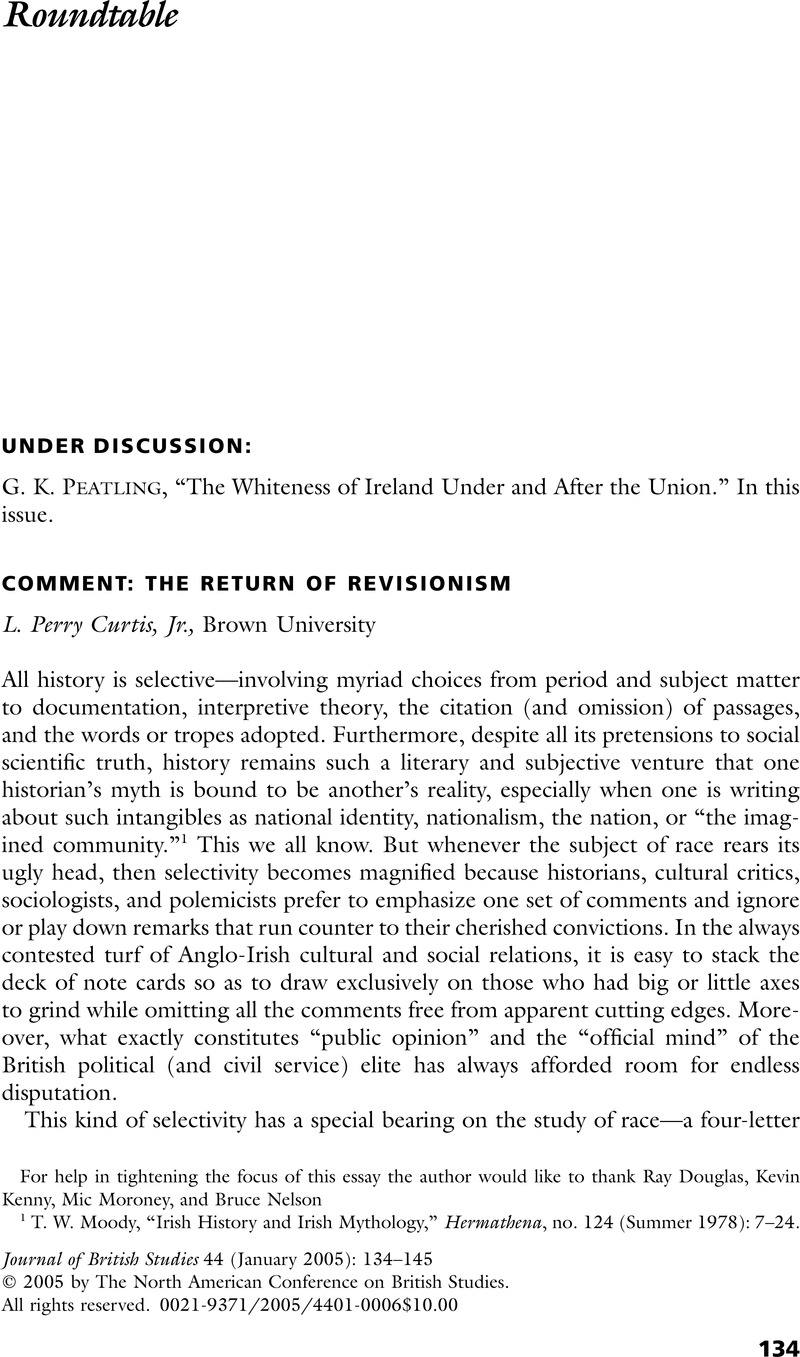Published online by Cambridge University Press: 21 December 2012

1 Kennedy, Liam, Colonialism, Religion and Nationalism in Ireland (Belfast, 1996), pp. 167–223Google Scholar.
2 Sawyer, Roger, Casement: The Flawed Hero (London, 1984)Google Scholar, quotation on p. 92; Dudgeon, Jeffrey, Roger Casement: The Black Diaries (Belfast, 2002)Google Scholar, quotation on p. 180. I thank Brian Lewis for these references.
3 Curtis, L. P. Jr., Anglo-Saxons and Celts: A Study of Anti-Irish Prejudice in Victorian England (New York, 1968), pp. 106–7Google Scholar.
4 Akenson, Donald Harman, The Irish Diaspora: A Primer (Toronto, 1993), pp. 141–51Google Scholar.
5 Gibbons, Luke, “‘The Return of the Native’: The United Irishmen, Culture and Colonialism,” in 1798: A Bicentenary Perspective, ed. Bartlett, Thomas, Dickson, David, Keogh, Daire, and Whelan, Kevin (Dublin, 2003), pp. 66–67, 70, 74Google Scholar.
6 Durey, Michael, Transatlantic Radicals and the Early American Republic (Lawrence, Kans., 1997), pp. 282–89Google Scholar; Wilson, David A., United Irishmen, United States: Immigrant Radicals in the Early Republic (Ithaca, N.Y., 1998), pp. 134–40Google Scholar; Kidd, Adam, The Huron Chief, ed. Bentley, D. M. R. (London, Ontario, 1987)Google Scholar.
7 Burk, John, The History of Virginia, from Its First Settlement to the Present Day (Petersburg, Va., 1804–5), 1:20–23, 31, 51, 99, 139–40, 240–41, 249–51, 308, 2:210–11, 216, 3:13–14, 30–43Google Scholar.
8 Malone, Dumas, The Public Life of Thomas Cooper, 1783–1839 (New Haven, Conn., 1926)Google Scholar; Graham, Jenny, Revolutionary in Exile: The Emigration of Joseph Priestley to America, 1794–1804 (Philadelphia, 1995), p. 87, n. 235Google Scholar.
9 Knobel, Dale T., Paddy and the Republic: Ethnicity and Nationality in Antebellum America (Middletown, Conn., 1986), pp. 88, 102–3, 179, 181Google Scholar.
10 Roediger, David R., The Wages of Whiteness: Race and the Making of the American Working Class (London, 1991), pp. 144–50Google Scholar; Ignatiev, Noel, How the Irish Became White (New York, 1995), pp. 1–3, 59Google Scholar.
11 Akenson, Donald Harman, Being Had: Historians, Evidence, and the Irish in North America (Port Credit, Ontario, 1985), pp. 37–75Google Scholar; Byron, Reginald, Irish America (Oxford, 1999), pp. 268–99Google Scholar.
12 Jensen, Richard, “‘No Irish Need Apply’: A Myth of Victimization,” Journal of Social History 36, no. 2 (2002): 405–19, 425–26CrossRefGoogle Scholar.
13 Knobel, Dale T., America for the Americans: The Nativist Movement in the United States (New York, 1996), pp. xvii–xxviii, 59–60, 142–53Google Scholar; Feldberg, Michael, The Philadelphia Riots of 1844: A Study of Ethnic Conflict (Westport, Conn., 1975), pp. 91–96Google Scholar.
14 Archdeacon, Thomas J., “The Irish Famine in American School Curricula,” in New Directions in Irish-American History, ed. Kenny, Kevin (Madison, Wis., 2003), pp. 280–301Google Scholar.
15 Ignatiev, How the Irish Became White, p. 3.
16 Boston Pilot (22 June 1844); see also Wilson, United Irishmen, United States, p. 57.
17 For some examples, see Boston Pilot (18 May, 17 August, 28 September, 26 October 1844) and American Celt (17 May 1851).
18 American Celt (31 August 1850).
19 Father John McCaffrey to Orestes Brownson, 15 December 1848, Orestes A. Brownson Papers, University of Notre Dame.
20 New York Shamrock (20 June 1812); American Patriot (13 November 1802).
21 American Celt (3 May 1851).
22 Irish Canadian (17 February 1864).
23 Emmet J. Mullally to Charles Murphy [1933] and 26 September 1933, Charles Murphy Papers, MG 27 III B 8, fols. 9345, 9347–50, National Archives of Canada.